Biofuel cell draws electrical power from its snail host
Researchers led by Evgeny Katz at Clarkson University have implanted a biofuel cell in a living snail.

According to a statement, this is the first incidence of an implanted biofuel cell continuously operating in a snail and producing electrical power over a long period of time using the snail’s physiologically produced glucose as a fuel.
The electrified snail, being a biotechnological living device, was able to regenerate glucose consumed by biocatalytic electrodes, upon appropriate feeding and relaxing, and then produce a new portion of electrical energy.
The snail with the implanted biofuel cell will be able to operate in a natural environment, producing sustainable electrical micropower for activating various bioelectronic devices.
Implantable biofuel cells have been suggested as sustainable micropower sources operating in living organisms, but such bioelectronic systems are still exotic and very challenging to design.
Similar research by Katz and other scientists is working toward a goal of creating insect cyborgs, an idea that has been funded by the US Department of Defense.
Few examples of abiotic and enzyme-based biofuel cells operating in living animals have been reported. Implantation of biocatalytic electrodes and extraction of electrical power from small living creatures is even more difficult and has not been achieved to date.
Register now to continue reading
Thanks for visiting The Engineer. You’ve now reached your monthly limit of news stories. Register for free to unlock unlimited access to all of our news coverage, as well as premium content including opinion, in-depth features and special reports.
Benefits of registering
-
In-depth insights and coverage of key emerging trends
-
Unrestricted access to special reports throughout the year
-
Daily technology news delivered straight to your inbox










UK Enters ‘Golden Age of Nuclear’
The delay (nearly 8 years) in getting approval for the Rolls-Royce SMR is most worrying. Signifies a torpid and expensive system that is quite onerous...